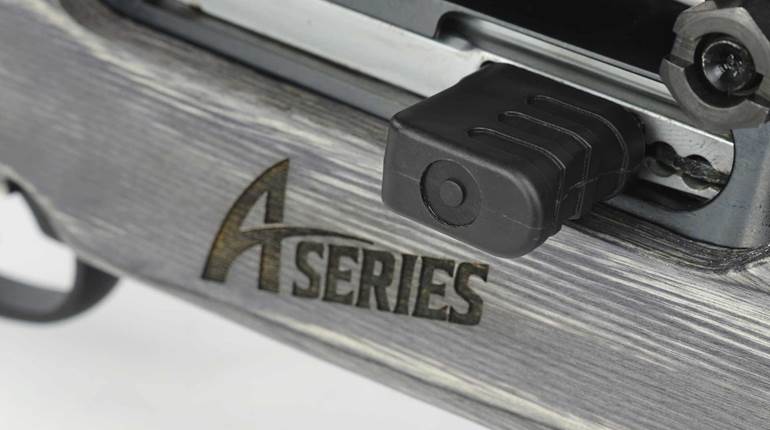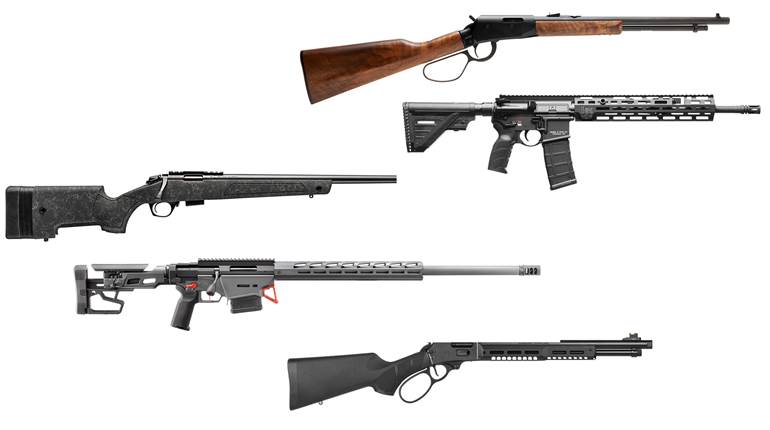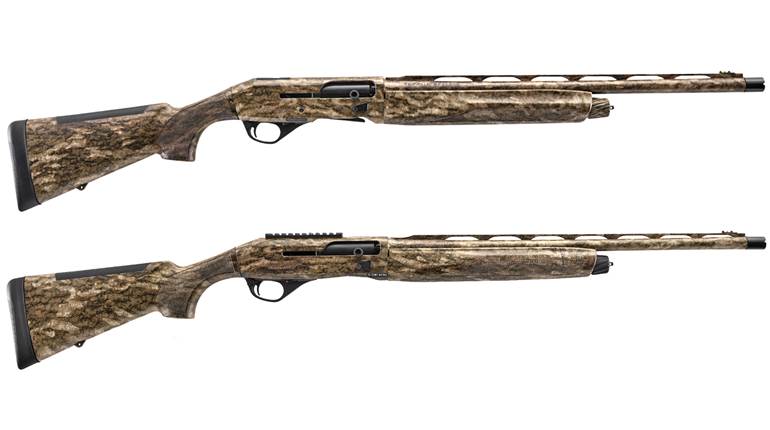
At 5'9" and of medium build, I am by no means a large man, but I’m not especially small either, and my arms are neither particularly long nor short for my frame. In contrast, a good friend of mine, who is also a shooter, stands 6'8" and his knuckles nearly drag on the ground as he ambles. On the other side of the equation, an acquaintance that also works in the industry is just barely tall enough to ride Space Mountain and has arms so short that clapping must present a struggle. Yet, absurdly, many gun manufacturers seem to believe that the three of us ought to share the same rifle. Human beings are not one-size-fits-all, and their firearms shouldn’t be either.
Tactical rifles and semi-automatic handguns have addressed this issue, to a degree, with collapsible buttstocks and interchangeable backstrap systems, respectively—and the benefits of properly fitting the firearm to its shooter have long been known within shotgunning circles—but most hunting rifles on the market today offer no provisions whatsoever for customizing the gun’s dimensions to better suit the user’s shape. And those that do are few and far between and often employ external knobs that can snag or work themselves loose at the most inopportune of times.
Custom stock makers do exist who can, if given an exacting list of measurements, craft a rifle to your precise physical shape and shooting style, but this avenue of fit comes with exorbitant price tags and lengthy wait times. At best, most high-volume gun manufacturers have adopted a two-sizes-fit-all philosophy, offering a “compact” option (which typically only varies in its truncated buttstock and barrel lengths) in addition to their full-size models.
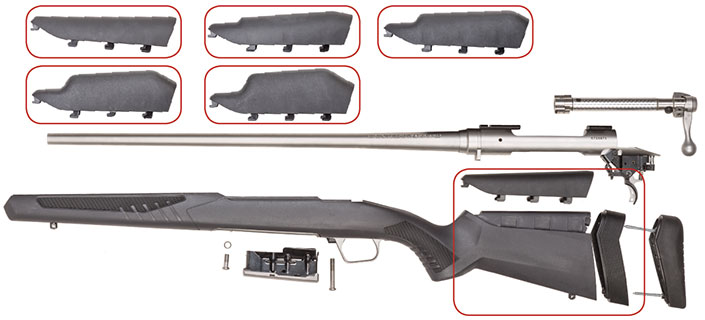
It is into this cookie-cutter atmosphere that, earlier this year, Savage Arms released nine rifles featuring the company’s new AccuFit synthetic stock design that allows shooters to customize both the firearm’s length of pull (LOP) and comb height (CH) easily with only a Phillips head screwdriver—while still maintaining the snag-free aesthetic of a hunting arm. The line includes a broad variety of models spanning a myriad of applications, from compact stalking models such as the Scout and the Wolverine, to heavier, long-barreled variants such as the Predator and the Long Range Hunter.

Eight of the nine AccuFit introductions replace a model previously cataloged by Savage (check the table on right to see which guns are being retired), while the Wolverine is a brand new design chambered exclusively for the thumping .450 Bushmaster—a rifle intended for those areas that stipulate the use of a straight-walled cartridge while hunting. Features, finishes, available chamberings and barrel lengths differ between the nine new offerings—with the Storm and Tactical models also being produced in left-hand actions—but beneath the hood each variant is built on Savage’s classic Model 110 action, and benefits from both the manufacturer’s AccuStock and AccuTrigger upgrades.
“Proper gun fit is comparable to a fine suit of clothes, improper gun fit to a cheap suit. Movements are natural and comfortable with the former, constrained and awkward with the latter.” Those words first appeared in American Rifleman back in 1971, and are no less accurate today. A stock that is overly long for the shooter can make the rifle awkward to handle and slow in the hands; a stock that is too short, or that does not facilitate a proper cheekweld, can batter the shooter with excessive recoil. Proper fit also speeds target acquisition, allowing the hunter to more rapidly and consistently get crosshairs on the quarry and take the first shot. The goal is to be perfectly aligned within the scope’s eye box when the rifle is naturally brought up to your shoulder at the optic’s highest magnification setting—it’s almost impossible to get optimal accuracy out of your rifle if your eye is constantly fighting with the scope.

AccuFit’s modularity is achieved by way of a system of polymer spacers and risers that allow the user to fine-tune the rifle’s shape to any combination of five different LOPs and five different CHs. Each gun ships from the factory with the straight comb and the longest spacer installed, however, four extra comb risers and three additional spacers of differing dimensions (the fifth and shortest LOP is accomplished by omitting a spacer altogether) are included in the box. As a result, length of pull on the AccuFit-equipped rifles can be set to between 12 1/2" and 13 1/2" in 1/4" increments, and drop at comb can be adjusted from 1¼" to 3/4" in 1/8" increments. Due to the downward-sloping angle of both the spacers and the recoil pad, the rifle’s drop at heel measurement will likewise vary depending on the spacer insert selected.
Each riser clips into the AccuFit stock using seven forward-sweeping tabs and is held in place at the rear by the selected LOP spacer. The spacer is then sandwiched between the stock and the rifle’s soft rubber buttpad, with a pair of screws running through the spacer and the recoil pad in order to secure both to the firearm. Four screw lengths are included with each gun (the one installed in the rifle plus three others), and the thickness of the spacer insert being used determines which set of screws will be utilized to attach the pad. The use of the longest insert (No. 4) requires the 2" screws, insert No. 3 necessitates 1¾" screws, insert No. 2 makes use of 1½" screws and the included 1¼" screws are appropriate for both insert No. 1 and when using no spacer at all. According to Savage, AccuFit’s spacer inserts are not intended to be stacked together.
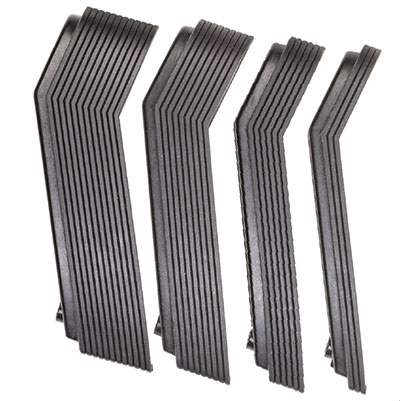
Making changes to the system is extremely simple. Start by removing the two screws from the butt of the recoil pad; this will allow the buttpad and the spacer to come free. Next, apply rearward pressure on the comb riser until the locking tabs clear their recesses in the top of the stock, and then lift the riser out. Now, select a new riser, place it into position and slide it forward until the front edge is flush with the stock. Choose the appropriate LOP insert and screw length, and then re-install the spacer and the buttpad. The only complicating factor in the process is that the recoil pad is made of such soft rubber that not only can it be slightly difficult to locate the head of the screw with the tip of the screwdriver, but the material grips your tool and adds resistance as you try to tighten or loosen the screws. These are minor issues, but they do slow down what is an otherwise foolproof operation.
Last fall, I had the opportunity to use one of Savage’s new AccuFit models—the Model 110 Storm chambered in .30-’06 Sprg.—during a pronghorn hunt in Wyoming. Topped with Cabela’s Instinct HD 3-9X 40 mm riflescope and firing Federal Premium’s 175-gr. Edge TLR load, I was able to successfully harvest a delicious speed goat, off-hand, from a distance of 207 yds. While zeroing-in our scopes prior to the hunt, it took about five minutes of trying different spacer and riser combinations in order to find my ideal fit; I personally found the most comfortable shape was attained by shortening the gun’s LOP by one setting and raising the comb up one increment from the factory configuration.
Fit is an important component of accuracy, yet I believe many shooters today are making do with ill-fitting guns and may not even realize it. Upon subsequently receiving the rifle back home for a more thorough technical evaluation, I had two others try out AccuFit for themselves. Using the same rifle with the same scope mounted in the same position, after experimenting with the various inserts, all three evaluators ultimately settled on a different fit configuration than the others—which pretty clearly illustrates why a system like AccuFit is such a good idea, and why the prevalent one-size-fits-all approach is so lacking.
But the arrival of AccuFit heralds more than just the introduction of a new feature, it also signals a shift by Savage toward more modern styling of its bolt-action line and a move by the company away from its convoluted and often puzzling model designation scheme. Regarding the former, the manufacturer’s existing synthetic stock molds were approaching the end of their service lives, so Savage took their imminent replacement as an opportunity to revamp the Model 110’s cosmetics and ergonomics. Among the tweaks made to the platform’s design are: a re-contoured pistol grip with more drop at the wrist to better accommodate smaller-handed shooters; a more squared-off trigger guard; a subtly re-shaped bolt knob; and a less rounded, flatter-bottomed fore-end more conducive to resting the rifle on a pack or a sandbag.
Forgoing more traditional checkering, purchase-enhancing overmolded rubber inserts have also been added to the pistol grip and fore-end of most of the new AccuFit models. Those rifles that feature a wider beavertail fore-end—such as the Tactical and the Varmint—bear etched-in texturing but not the soft-touch inserts. While the rubber inserts seem to be an AccuFit-specific feature at this point, for 2018, in addition to the AccuFit variants, Savage is also updating several of its other existing models with the rest of the changes mentioned above. The overall result of the alterations is a much sleeker looking, more angularly contoured rifle that some purists may struggle to warm up to. I personally prefer the new profile; there’s nothing wrong with a 21st century gun looking like a 21st century gun, and the changes are distinct enough to visually distinguish the new Savages from the hoi polloi of the contemporary bolt-action market.
Concerning Savage’s former penchant for employing alphabet soup in the naming of its gun models, moving forward the company is adopting a much more streamlined system of product identification—no decoder ring necessary. The old system was thricely confusing, bear with me: One, previously, short-action firearms were denoted by a two-digit model number and long-action and magnum guns were differentiated by a three-digit model number, so, an American Classic rifle was considered a Model 14 if chambered in .308 Win., but a Model 114 if chambered in .30-’06 Sprg. or .300 Win. Mag.
Secondly, using the prior naming convention—and speaking in very broad terms with numerous exceptions to these guidelines in evidence within the product lineup—law enforcement and precision niche guns received the Model 10/110 designation; hunting rifles with black actions were numbered as 11/111s; varminter and benchrest competition models were made 12/112s; the 14/114 was a wood-stocked hunting gun; and the 16/116 monikers were bestowed on hunting rifles with stainless steel receivers and barrels—despite all of the above sharing essentially identical actions. Thirdly, Savage would occasionally, but not always, name its models after features that the gun possessed, using a long string of letters to signify those characteristics. For example, in the case of the 11/111 FCNS (one of the models being replaced), customers would need to carry a cheat sheet around to know that “F” stands for “synthetic stock” for some reason, that “C” curiously indicates that the rifle feeds from a detachable box magazine and that “NS” is short for “no sights.”
Confused yet? So was everyone else, which is why Savage is mercifully abandoning all that complexity in favor of a pattern that everyone should be able to follow. Henceforth, all new center-fire rifle models based on the company’s Model 110 action—regardless of the length of that action and the application of the firearm—will simply be called Model 110s. Future releases will also avoid the acronym gobbledygook of the past. For those already familiar with Savage’s product lineup, existing models not being replaced or updated with the new stock design will not undergo a name change yet, but all forthcoming models will use the new naming conventions—so the task of fully putting the manufacturer’s intricate code system to rest may still take years or decades.
Savage Model 110 Storm
First designed in 1958, Savage’s Model 110 today stands as the longest continuously manufactured bolt-action rifle in America, and the new AccuFit-featured Model 110s—like the Storm evaluated here—represent the latest evolution of this esteemed line. The 110 Storm replaces the 16/116 FCSS Weather Warrior in the company’s catalog, and as such, is an all-weather hunting rifle that matches a 416 stainless steel barreled action with a gray synthetic stock. Both right- and left-hand models of the Storm are offered, with 15 chamberings available for righties and nine for southpaws—from short-action cartridges like .223 Rem. to magnums like .300 Win. Mag.

The Storm’s action is a push-feed system with a two-lug, floating bolt head that permits just enough movement to ensure 100 percent engagement of both lugs within the receiver during lockup. Although the design remains unchanged, the action is actually set slightly deeper into the stock of the Storm than it was on the Weather Warrior, resulting in a cleaner look and a lower bore axis. The rifle cocks upon opening, has a jeweled bolt body and utilizes a 90-degree bolt throw that is easy to manipulate from the shoulder. A sliding-plate extractor located in the right lug of the bolt pulls the cartridge from the chamber and a plunger-style ejector extends from the left side of the bolt face to subsequently expel the extracted case from the rifle. No sights come with the gun, however, the receiver is drilled and tapped for the installation of scope mounts. Sling swivel studs on the Storm are located similarly to those on the Weather Warrior—metal units screwed into the stock at the fore-end and the bottom of the buttstock.
Savage has used both top- and bottom-mounted bolt-release buttons over the years, and the control used on the Storm is an example of the latter type, located just forward of the trigger guard. The rifle’s tang-mounted, three-position safety allows the gun to be fired when pushed fully forward, locks the trigger but permits the bolt to cycle while in the center position, and secures both the bolt and the trigger when pulled to the rear setting. Our test rifle, a right-handed model chambered in .30-’06 Sprg., feeds from a detachable, four-round-capacity, center-feed magazine.

The 30-’06 Sprg. Storm’s 22" stainless steel, button-rifled barrel, like all Savage rifles, is threaded into the receiver at the minimal headspace value for the cartridge and then secured in place by way of a locknut. A sheet of paper slipped between the barrel and the fore-end confirmed that the barrel is indeed free-floated all the way to the locknut. The Storm’s thin, sporter-contour barrel ends, appropriately enough, in a standard, sporter-style crown.
As mentioned above, the new AccuFit rifles also make use of Savage’s AccuStock and AccuTrigger features. The former is a rigid, one-piece, milled-aluminum bedding block that spans the entirety of the rifle’s action and much of its fore-end, and is permanently epoxied to the stock. Rather than the stock engaging the action only at the action screws and only in one direction (downward), AccuStock allows for three-dimensional engagement along the action’s entire length—a cost-effective method of bedding proven to yield superbly repeatable accuracy. By extending its tongue forward of the action and into the fore-end, the system also adds sturdiness to that part, greatly diminishing the potential for the synthetic fore-end to flex enough that it comes into accuracy-robbing contact with the barrel.
Savage’s AccuTrigger is a user-adjustable design that allows for minimal trigger-to-sear contact while remaining safe from the risk of accidental discharge due to being dropped or jarred. The bottom of the AccuRelease blade bisects the trigger shoe, while the top blocks the movement of the sear—it is only by completely depressing the trigger that the rifle is capable of firing. While the AccuTrigger is a single-stage trigger, the slight resistance provided by the AccuRelease safety gives it the feel of a faux two-stage system. The trigger pull on the Storm is adjustable between 2 lbs., 8 ozs., and 6 lbs., and the average pull weight on our test gun measured 3 lbs., 8 ozs.; trigger breaks were crisp, take-up was nil and overtravel was minimal.
Accuracy testing of the Storm followed the standard American Rifleman protocol of shooting five consecutive, five-shot groups at 100 yds. using three loads: Federal’s 175-gr. Edge TLR (the ammunition used previously on the pronghorn hunt); Nosler’s 125-gr. Ballistic Tip; and Remington’s 180-gr. Core-Lokt. Each rifle is an individual, so your results will undoubtedly vary, but the single best group (0.71") was shot using the Nosler load, while the best five-group average (1.26") was produced with Federal’s Edge TLR, and both of these managed at least one sub-m.o.a. cluster. Across the three ammunition types, our test gun yielded an average extreme spread of 1.46", which is plenty accurate for hunting big game.
I’ve now used the Model 110 Storm a good bit, both in the field and at an indoor range, and have experienced no failures of any kind. Operation of the action has been smooth—there’s a decent amount of side-to-side and up-and-down wobble when the bolt is held all the way back—but it had no impact on the reliable cycling of the bolt. Upon first handling the gun, I was concerned that the AccuFit’s overmolded rubber grip inserts might not hold up well to rough use, but at this point they seem to be no worse for wear, although only time will tell whether they can stand up to many years of field use. Recoil of the .30-’06 Sprg. cartridge through a 7-lb. bolt-action is right on the outer limit of what I consider to be enjoyable, particularly during prolonged testing from a bench, but the Storm’s thick rubber recoil pad kept the shooting experience on the right side of that line.

All in all, I found very little not to like about Savage’s AccuFit, in general, and the Model 110 Storm, in particular. Savage’s newest feature allows you to achieve optimal fit with your hunting rifle in a manner that is simple, unobtrusive, reversible and economical—of the eight AccuFit models that have a non-AccuFit counterpart, two have MSRPs virtually identical to those of their predecessors, and the rest are less expensive than the rifles they are replacing. The Storm, in specific, will retail for $849, a decent reduction from the $939 price tag of the 16/116 FCSS Weather Warrior that it succeeds.
The system replaces Savage’s previous method of comb-height adjustment, that of a sleeve held in place by the tension of two screws bisecting the buttstock, and, in my opinion, represents a marked improvement. AccuFit allows the gun to be altered in response to a change in shooting position, clothing type or ownership. It also makes a ton of sense for youth shooters; its adaptability allows the rifle to grow with the child, fitting him or her now, yet able to change measurements as necessary to match the growing dimensions of its shooter.
AccuFit doesn’t directly cause the rifle to be any more accurate than it already is, however, in facilitating proper fit—improving the interface between the rifle and its shooter—the system does make it easier to shoot well. That the Savage Model 110 Storm and the eight other AccuFit-equipped models accomplish this while managing to be aesthetically pleasing and priced to move will likely make them very hard for value-conscious buyers to ignore.

Additional Reading:
The Keefe Report—Vista's Strategic Strategic Transformation Plan: Remain Calm
Vista CEO Vows "Ardent Support" for 2A Freedoms













